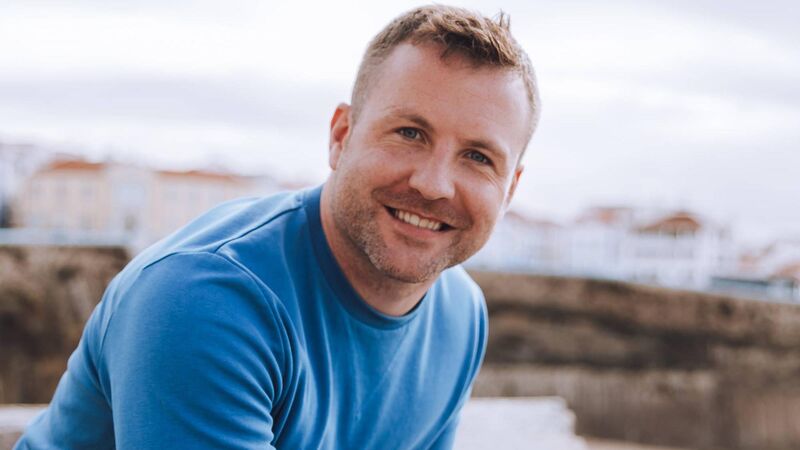Pat Divilly: This is how to deal with chronic stress and anxiety

Pat Divilly: "When in a ‘stress’ response within the body, we are focused solely on the immediate. We are impulsive, often irrational, focused only on survival, safety and comfort."
An analogy shared with me seven years ago by a psychologist began a big shift in how I’ve viewed and approached my mental health and wellness ever since.
During a visit at a time in which I was feeling overwhelmed and in a chronic state of stress and anxiety, the conversation turned to the analogy of a fire alarm.
The psychologist noted that we all have a fire alarm in our house, the purpose of which is to pick up on cues of danger and produce an alarm when there is a potential threat, signalling the need to get to safety.
This of course is useful and could potentially save our lives in the case of an emergency. However, sometimes the fire alarm malfunctions and begins beeping every time we use the toaster or oven. It’s no longer doing its job effectively and becomes a nuisance.
Similarly, she told me we all have an internal alarm, there to pick up on and respond to signs of danger in our environment by informing our bodies of what we need immediately in order to stay safe.
If a threat emerges, without having to consciously think about it, the alarm goes off and your nervous system will give your body the cue to increase heart rate, move to faster more shallow breathing, produce stress hormones and energy in the body and get ready to fight, flight, freeze or fawn (instinctive survival strategies to stay safe).
When in a ‘stress’ response within the body, we are focused solely on the immediate. We are impulsive, often irrational, focused only on survival, safety and comfort.
In the immediacy of these survival states, our body reacts before our mind has even figured out what’s going on.
This is useful in acute scenarios where there is a real threat to our physical safety.
If a car pulls out in front of me, I don’t want to have to stop and think about how I should respond. I want my system to quickly shift gears and give me the response I need in that exact moment.
In these moments in which my body goes into a survival response, all other functions take a back seat. Rest and recovery are not appropriate in these times, immune function and reproduction move down the priorities list. Creativity, logic and perspective go ‘offline’ and our focus narrows only to see the potential threat in front of us.
All resources are channelled into survival with all other functions of health put on hold.
This is perfect in incidences of real potential danger, though much like the malfunctioning fire alarm in the house that goes when we use the toaster, we can often find our bodies and minds responding in a dysfunctional way, cueing signs of danger and threat, when in reality there is no real danger.

The perception of danger can signal the same reactions from our bodies as real danger and thoughts of the future and past lead to the same stress responses within the body. While we may think of stress, anxiety or struggles with mental health as being related to what’s going on in the head, we must recognise the impact of what is going on in the body.
We can sometimes find ourselves stuck in these dysregulated states where rather than a short term response to keep us safe we remain in a hyper-vigilant state of survival.
Extended time spent in these survival states leave us living life in reactivity and, as was the case for me seven years ago during this trip to the psychologist, it becomes impossible to outthink these stresses or problems in the mind (as we lose access to the parts of the brain where we can find perspective and possibilities).
Much of the mental health conversation tends to focus on thoughts, emotions and behaviours and often the role of the body and our environment can be overlooked or seen as separate.
This overlooks the reality that what is happening in our bodies heavily influences our thoughts, emotions and behaviours and that what is happening in our bodies is generally a response to the level of safety of danger we feel within our environments.
I believe a key piece in improving mental health is to become increasingly attuned to what is being experienced in our body, noticing stress responses and ‘soothing’ ourselves through reminders that we are safe and not under threat. Every time we do this we regain access to perspective, possibility and other key functions of a healthy body and mind.
I have seen the word, ‘resilience,’ popping up more and more frequently in recent years with varying viewpoints on what resilience is or what role it plays in our lives.
For me, resilience relates directly to the health of our nervous system. A resilient person is someone with a nervous system that can ‘shift gears’, moving in and out of different states of stress and relaxation at will.
It isn’t that we always want to be calm or mellow; there are times where stress is appropriate and helpful. The key is that we can maintain awareness of what we are experiencing and can shift states when our current state is no longer supporting us.
As an example, if I am to notice feelings of anxiety or fear, rather than trying to outthink or get past my feelings, I want to bring attention to the body.
Perhaps I’ll notice tension, tightness, a short breath or an elevated heart rate. Recognising that, along with these signs will come a mind focused on threats and survival, I want to ease these sensations in my body to allow myself to regain access to my human mind and move out of this survival state so I can find perspective and solutions.
We call this practice of bringing ourselves back to a state of safety, ‘regulating’. It is the practice of noticing how we feel and giving ourselves what we need.
In much the same way as a parent might notice their child cries as a signal that the child needs support or a feeling of safety, we can start to see our own challenging emotions or bodily sensations as an invitation to practice self care through regulation tools.
We all have a different life history and because of this we will have different interpretations of what brings safety and what brings danger. As such, it is important that we start to piece together a tool box of things we can turn to in order to to ‘slow things down’ in an overstimulated world.
Many people enjoy breath work, meditation, time in nature, exercising, connecting with friends or listening to their favourite music.
It’s important you find a variety of options that work for you. Below I’ve included a few examples, though again the key in developing resiliency and improved mental health is in noticing our bodily experience and creating safety in times where we have become activated. This, like anything, is a practice that we can improve upon with time.
Coherence Breathing
The way that we breathe has a profound effect on how we feel both in body and mind. A short, fast, shallow breath through the mouth will quickly bring about a sense of things speeding up, whilst a slow deep breath through the nose and into the belly will create a sense of things slowing down.
I often use the analogy of a car with its accelerator and brakes to describe the nervous system. In times of elevated stress and the perception of threat, it is as though the accelerator is being pushed down hard. Things get faster: breath, heart rate and our thoughts. The faster things get the more out of control we can begin to feel and a crash is inevitable.
Coherence breathing is one of many breathwork techniques that can help us practise coming back to a sense of safety and calm within the body. This breath simply involves breathing in and out through the nose for a cadence of a five second inhale, followed by a five second exhale.
This brings us down to six breaths per minute, half the usual number of breaths taken per minute on average.
As a result the nervous system shifts into a relaxed state creating a sense of safety in body and mind. Consider this as a five to ten minute daily practice.
Shaking
There is an amazing video available online that demonstrates a polar bear’s response to an overwhelming experience of stress by falling to its side and shaking once it’s gotten to safety.
The polar bear, while being tracked by researchers in a helicopter experiences a fight or flight response in which an abundance of energy floods their body, the muscles become activated and a chemical cocktail resources the bear, allowing them to flee from the potential threat of the helicopter. (We might experience similar sensations when called in for a meeting with our boss.) Once the polar bear has reached safety, they complete the ‘arousal cycle’ and come back to a state of balance by shaking to dislodge the excess of energy it will have experienced in its ‘fight or flight response’.
Humans have access to this same means of stress and tension release through a process called neurogenic tremors, though we often focus more on talking about what happened rather than coming into the body and completing these arousal cycles.
You’ll sometimes see someone’s hand shaking when they are nervous, an example of the body’s efforts to dislodge excess energy and find a state of balance and safety.
Trauma Release Exercises (TRE), connected breath work and neurogenic yoga are two practices that can help facilitate the practice of letting go through the body.
Connection
Returning to the fire alarm analogy at the start of this piece: consider what happens when we hear a real fire alarm going off in a public space. Before moving to our defence strategies of fight or flight, we’ll instinctively make eye contact with those around us in an effort to gauge whether this is a real threat or false alarm.
This shows us the power of connection and how connection to others can elicit feelings of safety in times of stress.
It is in connection to our maternal figures that we first learn regulation. A baby experiencing challenging emotions, unable to soothe and provide safety for themselves will be soothed by their mother. As adults in times of stress or overwhelming emotion, reaching out for support can be a way of reminding ourselves that we are safe.
Difficult emotions or shame can leave us feeling isolated and withdrawn, though sharing our burdens with people we can trust can remind us of our shared humanity. Consider who in your life you can reach out to for support when you feel overwhelmed and look to remind yourself of times in the past when sharing your challenges or feelings helped lighten the load.
Journalling
Without awareness, we have no choice in how we react to ‘triggering’ situations as survival and defensive strategies take over, leading us to repeating old patterns on auto-pilot.
Writing about situations which frequently lead to fear, shame, reactivity, anger or other challenging emotions can help us increase awareness and develop new strategies to respond to the situation rather than react.
It can be useful to outline a situation that leads to reactivity, identify the emotion being experienced and note how we currently respond.
Maybe for example I notice when my boss emails me on the weekend I feel angry and my reaction is to get snappy with my family members because I am afraid to direct my anger at my boss. This awareness shows me a trigger, and offers me the chance to perhaps respond in a different way the next time I experience something similar.
Without awareness there can be no change and so journalling can be a really useful ally in this process.
- Pat Divilly is the author of the #1 bestseller. Fit Mind, and the host of the popular Pat Divilly Podcast. He holds an MSc in Exercise and Nutrition Science and has completed a year long professional training in Compassionate Inquiry, a psychotherapeutic approach developed by Dr. Gabor Mate. Pat will host a number of men’s workshops in April and May. Visit patdivilly.com for more.

Unlimited access. Half the price.
Try unlimited access from only €1.50 a week
Already a subscriber? Sign in
CONNECT WITH US TODAY
Be the first to know the latest news and updates

Celebrating 25 years of health and wellbeing










